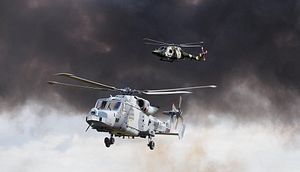South Korea received the first batch of four AgustaWestland AW Wildcat 159 shipborne anti-submarine warfare (ASW) helicopters from Anglo-Italian defense contractor Leonardo-Finmeccanica on June 13, Yonhap News reports.
The helicopters will now undergo flight and weapon trials before being officially inducted into the Republic of Korea (ROK) Navy by the middle of 2017. Four more helicopters are expected to be delivered by the year’s end. (There are also talks over an order of 12 additional helicopters.)
The AW Wildcat 159 outperformed the U.S.-made MH-60R Seahawk helicopter during a competitive bidding process under South Korea’s Defense Acquisition Program Administration’s so-called Maritime Operational Helicopter program. The government agency announced the selection of the European aircraft in January 2013.
The AW Wildcat 159’s will be stationed aboard Incheon-class guided-missile frigate to boost the ship’s anti-submarine warfare capabilities. The ROK Navy currently operates five regular 2,300-ton Incheon–class frigates, and expects to add six to nine improved Incheon-class vessels in the future.
Initially, the AW Wildcat 159s were slated for delivery by the third quarter of 2015. However, the introduction has been delayed by a corruption scandal inside South Korea’s military on the one hand, and delays during so-called site acceptance tests (SATs) on the other hand.
“The SATs are taking longer than expected but we are working with the customer to reduce the impact on the whole program,” a Leonardo-Finmeccanica company representative told IHS Jane’s Defense Weekly at the Singapore Airshow in February 2016.
The helicopter, “designed to operate from the smallest helicopter-capable ship,” according to the the Leonardo-Finmeccanic company website, is powered by two LHTEC CTS800-4N engines and has a maximum range of 265 nautical miles (490 kilometers). It primarily functions as a ASW aircraft, but can also be deployed in other missions.
“The platform is equipped with the latest communications, navigation systems, advanced sensors and a wide range of weapons, providing mission commanders with Intelligence Surveillance and Reconnaissance (ISR), Maritime Interdiction Operations (MIO), Anti Surface Warfare (ASuW), Anti Submarine Warfare (ASW) and Search and Rescue (SAR) capabilities,” according to the company website.
The helicopters will be equipped with a Selex Seaspray 7000E active electronically scanned array radar and a Thales Compact FLASH Sonics low-frequency, long-range dipping sonar system, next to other ASW sensors, including sonobuoys.
The multi-mission maritime helicopter will likely be armed with Spike NLOS missiles, K745 Cheong Sangeo (Blue Shark) light-weight torpedoes and depth charges. The aircraft can stay in the air for 2-3 hours depending on the load.































